Class 8 Maths Chapter 9 Algebraic Expressions and Identities All Exercise NCERT Solutions
- Class 8 Maths Algebraic Expressions and Identities Exercise 9.1
- Class 8 Maths Algebraic Expressions and Identities Exercise 9.2
- Class 8 Maths Algebraic Expressions and Identities Exercise 9.3
- Class 8 Maths Algebraic Expressions and Identities Exercise 9.4
- Class 8 Maths Algebraic Expressions and Identities Exercise 9.5
NCERT Solutions for Class 8 Maths Chapter 9 Algebraic Expressions and Identities Exercise 9.1
Ex 9.1 Class 8 Maths Question 1.
Identify the terms, their coefficients for each of the following expressions.
(i) 5xyz2 – 3zy
(ii) 1 + x + x2
(iii) 4x2y2 – 4x2y2z2 + z2
(iv) 3 – pq + qr – rp
(v)
(vi) 0.3a – 0.6ab + 0.5b
Solution: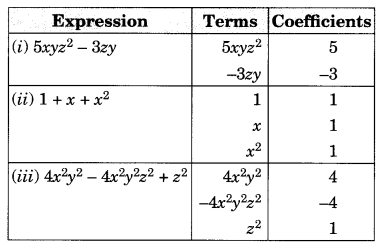
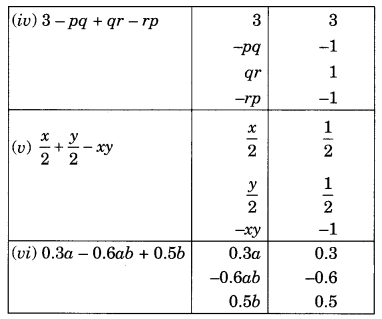
Ex 9.1 Class 8 Maths Question 2.
Classify the following polynomials as monomials, binomials, trinomials. Which polynomials do not fit in any of these three categories?
x + y, 1000, x + x2 + x3 + x4, 7 + y + 5x, 2y – 3y2, 2y – 3y2 + 4y3, 5x – 4y + 3xy, 4z – 15z2, ab + bc + cd + da, pqr, p2q + pq2, 2p + 2q
Solution: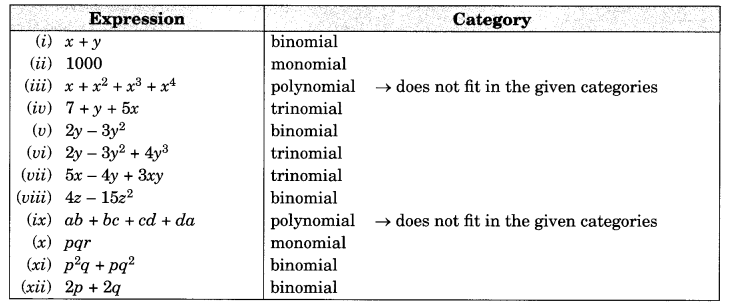
Ex 9.1 Class 8 Maths Question 3.
Add the following:
(i) ab – bc, bc – ca, ca – ab
(ii) a – b + ab, b – c + bc, c – a + ac
(iii) 2p2q2 – 3pq + 4, 5 + 7pq – 3p2q2
(iv) l2 + m2, m2 + n2, n2 + l2, 2lm + 2mn + 2nl
Solution:
(i) Given: ab – bc, bc – ca, ca – ab
We have
(ab – bc) + (bc – ca) + (ca – ab) (Adding all the terms)
= ab – bc + bc – ca + ca – ab
= (ab – ab) + (bc – bc) + (ca – ca) (Collecting the like terms together)
= 0 + 0 + 0
= 0
(ii) Given:
a – b + ab, b – c + bc, c – a + ac
We have (a – b + ab) + (b – c + bc) + (c – a + ac) (Adding all the terms)
= a – b + ab + b – c + bc + c – a + ac
= (a – a) + (b – b) + (c – c) + ab + bc + ac (Collecting all the like terms together)
= 0 + 0 + 0 + ab + bc + ac
= ab + bc + ac
(iii) Given:
2p2q2 – 3pq + 4, 5 + 7pq – 3p2q2
By arranging the like terms in the same column, we have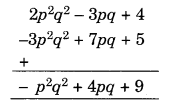
(Adding columnwise)
(iv) Given: l2 + m2, m2 + n2, n2 + l2, 2lm + 2mn + nl
By arranging the like terms in the same column, we have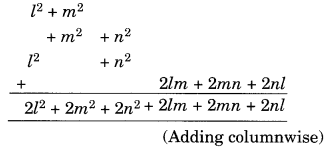
Thus, the sum of the given expressions is 2(l2 + m2 + n2 + lm + mn + nl)
Ex 9.1 Class 8 Maths Question 4.
(a) Subtract 4a – 7ab + 3b + 12 from 12a – 9ab + 5b – 3
(6) Subtract 3xy + 5yz – 7zx from 5xy – 2yz – 2zx + 10xyz
(c) Subtract 4p2q – 3pq + 5pq2 – 8p + 7q – 10 from 18 – 3p – 11q + 5pq – 2pq2 + 5p2q
Solution:
(a) Arranging the like terms column-wise, we have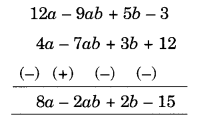
[Change the signs of all the terms of lower expressions and then add]
(b) Arranging the like terms column-wise, we have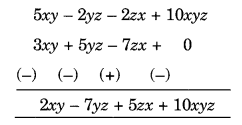
[Change the signs of all the terms of lower expressions and then add]
(c) Arranging the like terms column-wise, we have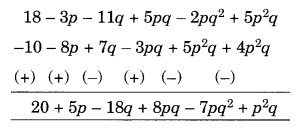
[Change the signs of all the terms of lower expressions and then add]
The terms are p2q – 7pq2 + 8pq – 18q + 5p + 20
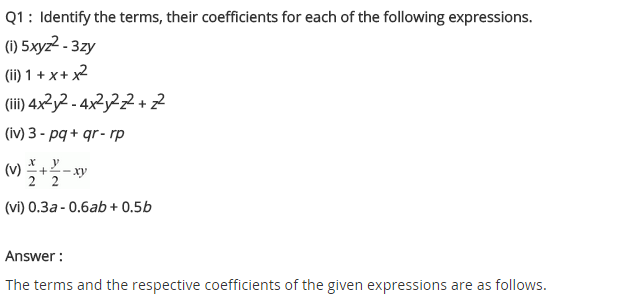
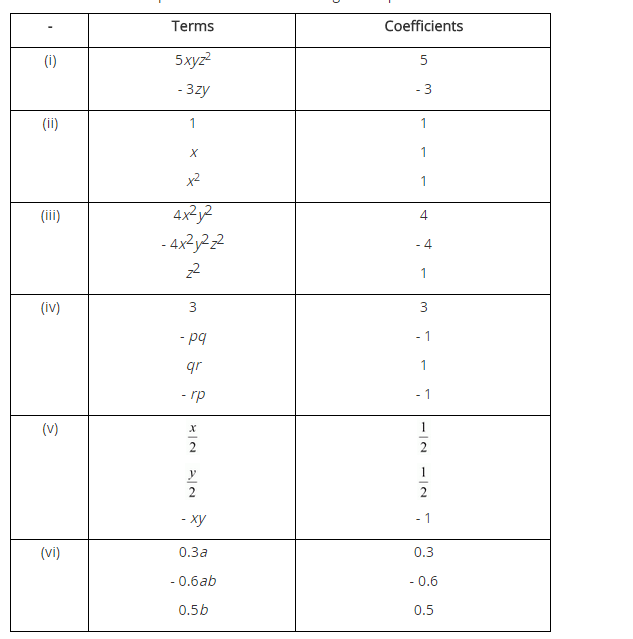
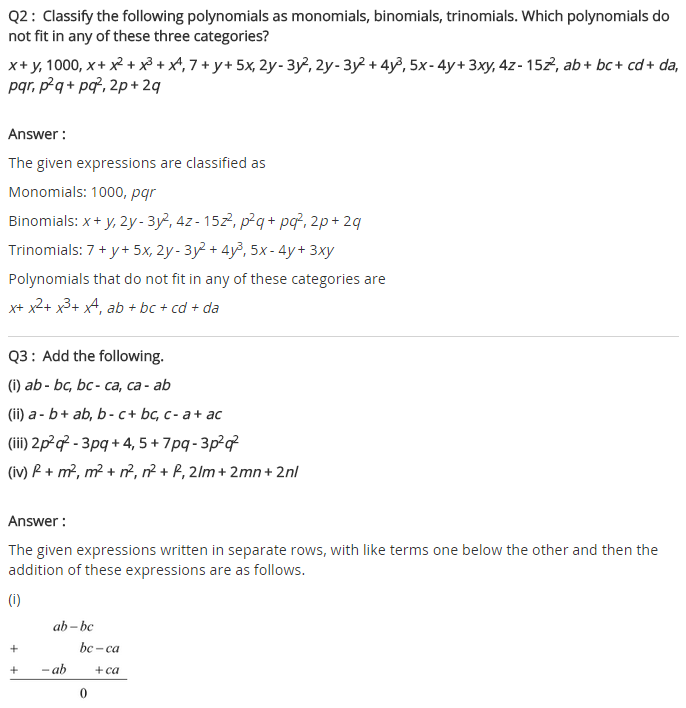
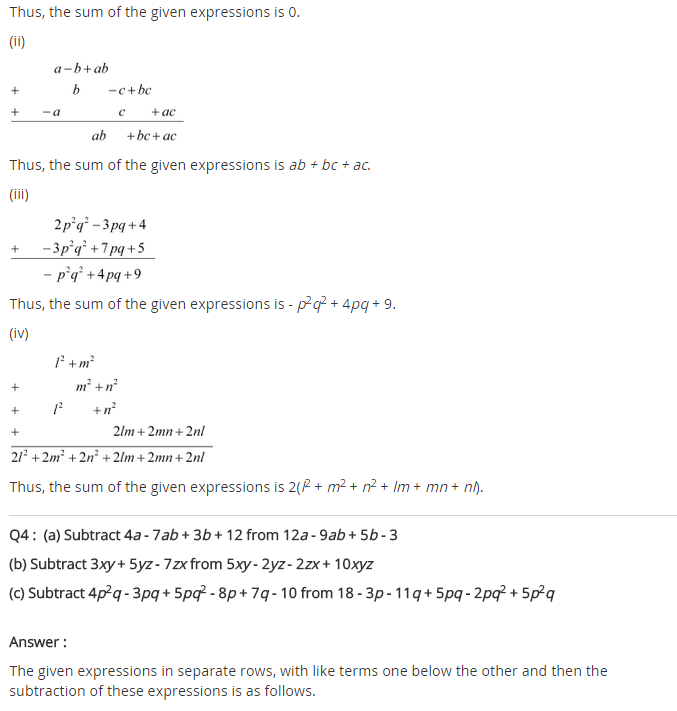
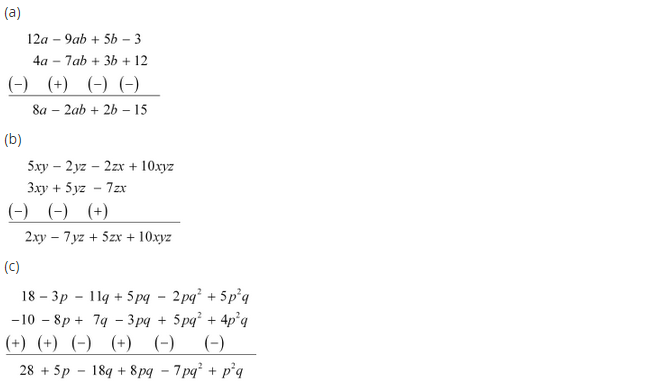
NCERT Solutions for Class 8 Maths Chapter 9 Algebraic Expressions and Identities Exercise 9.2
Ex 9.2 Class 8 Maths Question 1.
Find the product of the following pairs of monomials.
(i) 4, 7p
(ii) -4p, 7p
(iii) -4p, 7pq
(iv) 4p3, -3p
(v) 4p, 0
Solution:
(i) 4 × 7p = (4 × 7) × p = 28p
(ii) -4p × 7p = (-4 × 7) × p × p = -28p2
(iii) -4p × 7pq = (-4 × 7) × p × pq = -28p2q
(iv) 4p3 × -3p = (4 × -3) × p3 × p = -12p4
(v) 4p x 0 = (4 × 0) × p = 0 × p = 0
Ex 9.2 Class 8 Maths Question 2.
Find the areas of rectangles with the following pairs of monomials as their lengths and breadths respectively.
(p, q); (10m, 5n); (20x2, 5y2); (4x, 3x2); (3mn, 4np)
Solution:
(i) Length = p units and breadth = q units
Area of the rectangle = length × breadth = p × q = pq sq units
(ii) Length = 10 m units, breadth = 5n units
Area of the rectangle = length × breadth = 10 m × 5 n = (10 × 5) × m × n = 50 mn sq units
(iii) Length = 20x2 units, breadth = 5y2 units
Area of the rectangle = length × breadth = 20x2 × 5y2 = (20 × 5) × x2 × y2 = 100x2y2 sq units
(iv) Length = 4x units, breadth = 3x2 units
Area of the rectangle = length × breadth = 4x × 3x2 = (4 × 3) × x × x2 = 12x3 sq units
(v) Length = 3mn units, breadth = 4np units
Area of the rectangle = length × breadth = 3mn × 4np = (3 × 4) × mn × np = 12mn2p sq units
Ex 9.2 Class 8 Maths Question 3.
Complete the table of Products.
Solution:
Completed Table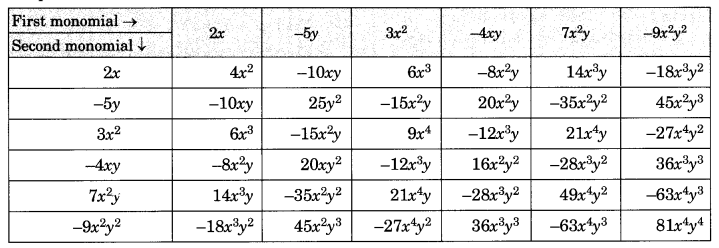
Ex 9.2 Class 8 Maths Question 4.
Obtain the volume of rectangular boxes with the following length, breadth and height respectively.
(i) 5a, 3a2, 7a4
(ii) 2p, 4q, 8r
(iii) xy, 2x2y, 2xy2
(iv) a, 2b, 3c
Solution:
(i) Here, length = 5a, breadth = 3a2, height = 7a4
Volume of the box = l × b × h = 5a × 3a2 × 7a4 = 105 a7 cu. units
(ii) Here, length = 2p, breadth = 4q, height = 8r
Volume of the box = l × b × h = 2p × 4q × 8r = 64pqr cu. units
(iii) Here, length = xy, breadth = 2x2y, height = 2xy2
Volume of the box = l × b × h = xy × 2x2y × 2xy2 = (1 × 2 × 2) × xy × x2y × xy2 = 4x4y4 cu. units
(iv) Here, length = a, breadth = 2b, height = 3c
Volume of the box = length × breadth × height = a × 2b × 3c = (1 × 2 × 3)abc = 6 abc cu. units
Ex 9.2 Class 8 Maths Question 5.
Obtain the product of
(i) xy, yz, zx
(ii) a, -a2, a3
(iii) 2, 4y, 8y2, 16y3
(iv) a, 2b, 3c, 6abc
(v) m, -mn, mnp
Solution:
(i) xy × yz × zx = x2y2z2
(ii) a × (-a2) × a3 = -a6
(iii) 2 × 4y × 8y2 × 16y3 = (2 × 4 × 8 × 16) × y × y2 × y3 = 1024y6
(iv) a × 2b × 3c × 6abc = (1 × 2 × 3 × 6) × a × b × c × abc = 36 a2b2c2
(v) m × (-mn) × mnp = [1 × (-1) × 1 ]m × mn × mnp = -m3n2p
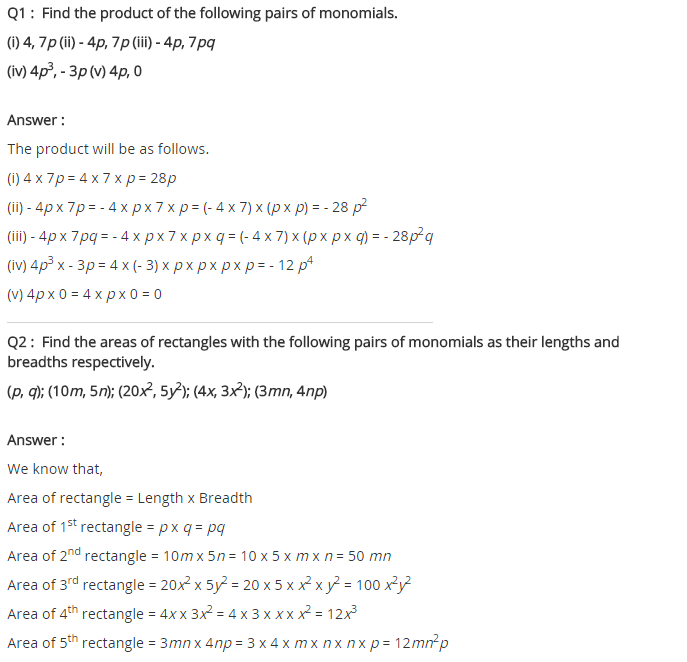
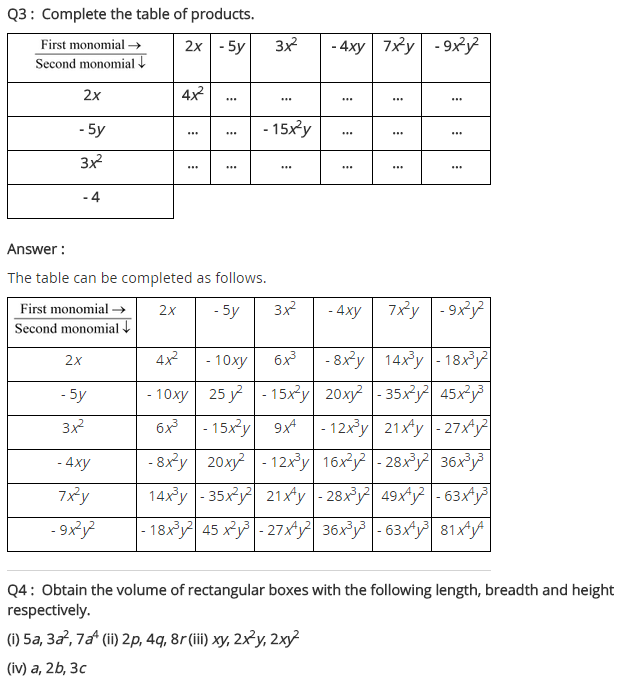
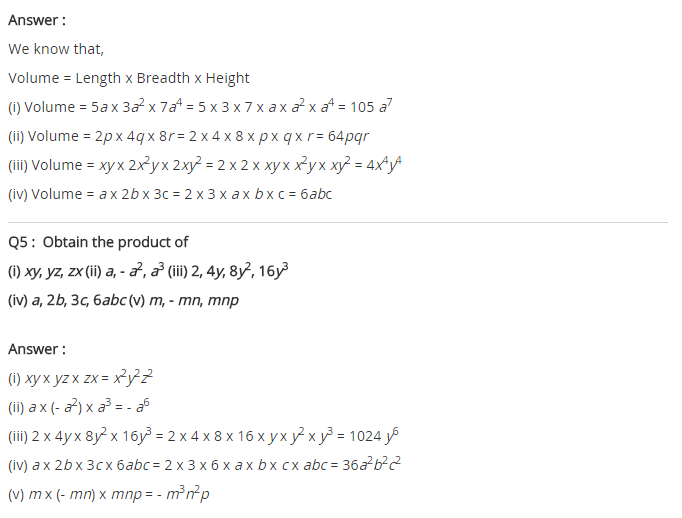
NCERT Solutions for Class 8 Maths Chapter 9 Algebraic Expressions and Identities Exercise 9.3
Ex 9.3 Class 8 Maths Question 1.
Carry out the multiplication of the expressions in each of the following pairs:
(i) 4p, q + r
(ii) ab, a – b
(iii) a + b, 7a2b2
(iv) a2 – 9, 4a
(v) pq + qr + rp, 0
Solution:
(i) 4p × (q + r) = (4p × q) + (4p × r) = 4pq + 4pr
(ii) ab, a – b = ab × (a – b) = (ab × a) – (ab × b) = a2b – ab2
(iii) (a + b) × 7a2b2 = (a × 7a2b2) + (b × 7a2b2) = 7a3b2 + 7a2b3
(iv) (a2 – 9) × 4a = (a2 × 4a) – (9 × 4a) = 4a3 – 36a
(v) (pq + qr + rp) × 0 = 0
[∵ Any number multiplied by 0 is = 0]
Ex 9.3 Class 8 Maths Question 2.
Complete the table.
S.No. | First Expression | Second Expression | Product |
| (i) | a | b + c + d | – |
| (ii) | x + y – 5 | 5xy | – |
| (iii) | p | 6p2 – 7p + 5 | – |
| (iv) | 4p2q2 | p2 – q2 | – |
| (v) | a + b + c | abc | – |
Solution:
(i) a × (b + c + d) = (a × b) + (a × c) + (a × d) = ab + ac + ad
(ii) (x + y – 5) (5xy) = (x × 5xy) + (y × 5xy) – (5 × 5xy) = 5x2y + 5xy2 – 25xy
(iii) p × (6p2 – 7p + 5) = (p × 6p2) – (p × 7p) + (p × 5) = 6p3 – 7p2 + 5p
(iv) 4p2q2 × (p2 – q2) = 4p2q2 × p2 – 4p2q2 × q2 = 4p4q2 – 4p2q4
(v) (a + b + c) × (abc) = (a × abc) + (b × abc) + (c × abc) = a2bc + ab2c + abc2
Completed Table:
S.No. | First Expression | Second Expression | Product |
| (i) | a | b + c + d | ab + ac + ad |
| (ii) | x + y – 5 | 5xy | 5x2y + 5xy2 – 25xy |
| (iii) | p | 6p2 – 7p + 5 | 6p3 – 7p2 + 5p |
| (iv) | 4p2q2 | p2 – q2 | 4p4q2 – 4p2q4 |
| (v) | a + b + c | abc | a2bc + ab2c + abc2 |
Ex 9.3 Class 8 Maths Question 3.
Find the products.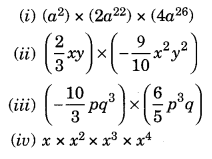
Solution: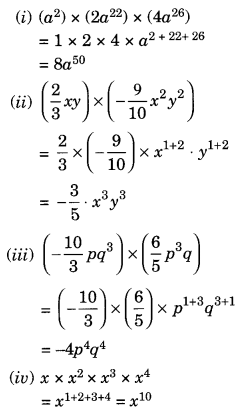
Ex 9.3 Class 8 Maths Question 4.
(a) Simplify: 3x(4x – 5) + 3 and find its values for (i) x = 3 (ii) x =
(b) Simplify: a(a2 + a + 1) + 5 and find its value for (i) a = 0 (ii) a = 1 (iii) a = -1
Solution:
(a) We have 3x(4x – 5) + 3 = 4x × 3x – 5 × 3x + 3 = 12x2 – 15x + 3
(i) For x = 3, we have
12 × (3)2 – 15 × 3 + 3 = 12 × 9 – 45 + 3 = 108 – 42 = 66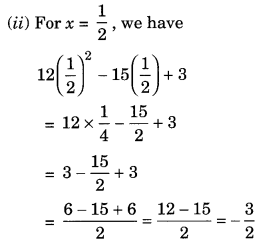
(b) We have a(a2 + a + 1) + 5
= (a2 × a) + (a × a) + (1 × a) + 5
= a3 + a2 + a + 5
(i) For a = 0, we have
= (0)3 + (0)2 + (0) + 5 = 5
(ii) For a = 1, we have
= (1)3 + (1)2 + (1) + 5 = 1 + 1 + 1 + 5 = 8
(iii) For a = -1, we have
= (-1)3 + (-1)2 + (-1) + 5 = -1 + 1 – 1 + 5 = 4
Ex 9.3 Class 8 Maths Question 5.
(a) Add: p(p – q), q(q – r) and r(r – p)
(b) Add: 2x(z – x – y) and 2y(z – y – x)
(c) Subtract: 3l(l – 4m + 5n) from 4l(10n – 3m + 2l)
(d) Subtract: 3a(a + b + c) – 2b(a – b + c) from 4c(-a + b + c)
Solution:
(a) p(p – q) + q(q – r) + r(r – p)
= (p × p) – (p × q) + (q × q) – (q × r) + (r × r) – (r × p)
= p2 – pq + q2 – qr + r2 – rp
= p2 + q2 + r2 – pq – qr – rp
(b) 2x(z – x – y) + 2y(z – y – x)
= (2x × z) – (2x × x) – (2x × y) + (2y × z) – (2y × y) – (2y × x)
= 2xz – 2x2 – 2xy + 2yz – 2y2 – 2xy
= -2x2 – 2y2 + 2xz + 2yz – 4xy
= -2x2 – 2y2 – 4xy + 2yz + 2xz
(c) 4l(10n – 3m + 2l) – 3l(l – 4m + 5n)
= (4l × 10n) – (4l × 3m) + (4l × 2l) – (3l × l) – (3l × -4m) – (3l × 5n)
= 40ln – 12lm + 8l2 – 3l2 + 12lm – 15ln
= (40ln – 15ln) + (-12lm + 12lm) + (8l2 – 3l2)
= 25ln + 0 + 5l2
= 25ln + 5l2
= 5l2 + 25ln
(d) [4c(-a + b + c)] – [3a(a + b + c) – 2b(a – b + c)]
= (-4ac + 4bc + 4c2) – (3a2 + 3ab + 3ac – 2ab + 2b2 – 2bc)
= -4ac + 4bc + 4c2 – 3a2 – 3ab – 3ac + 2ab – 2b2 + 2bc
= -3a2 – 2b2 + 4c2 – ab + 6bc – 7ac
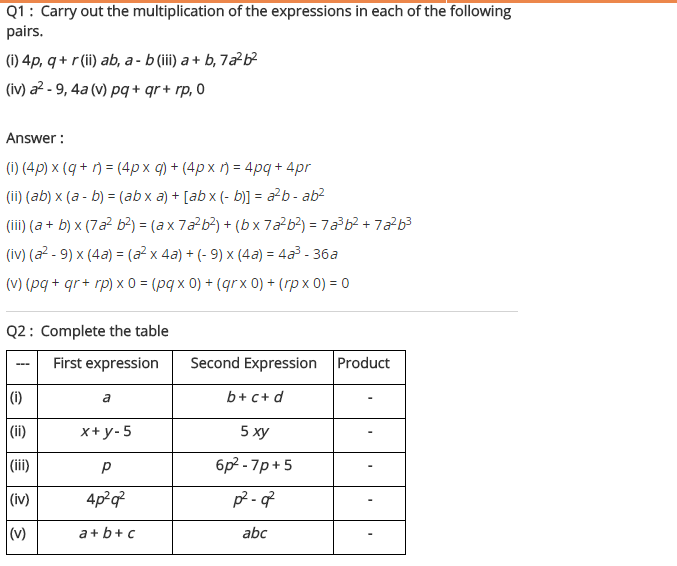
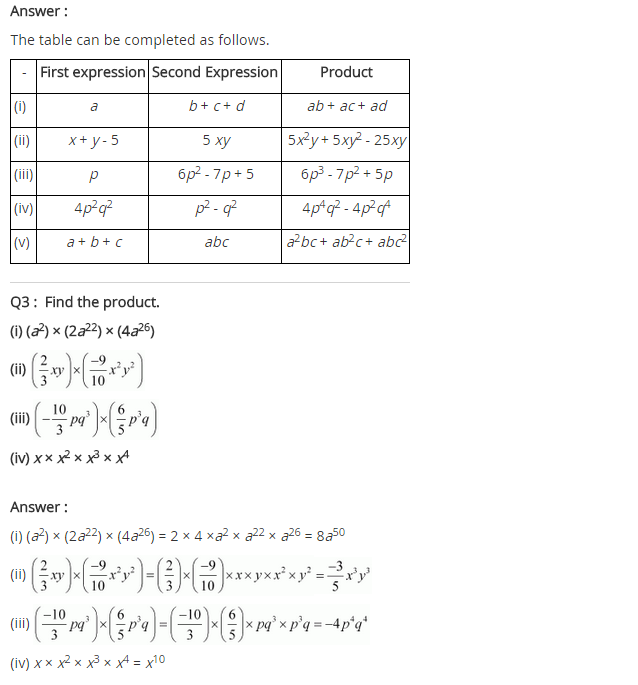
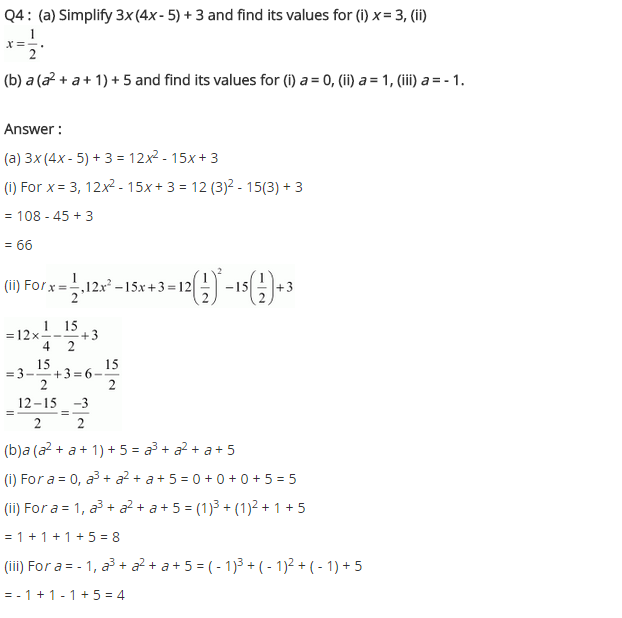
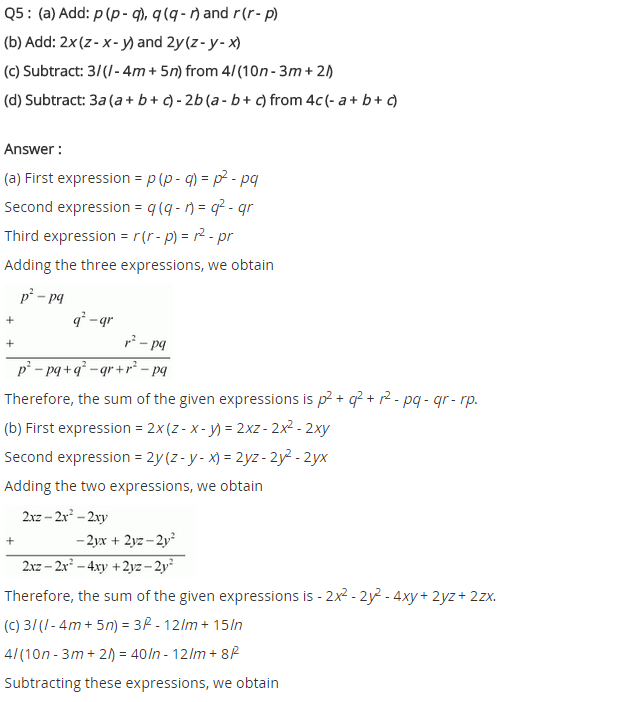
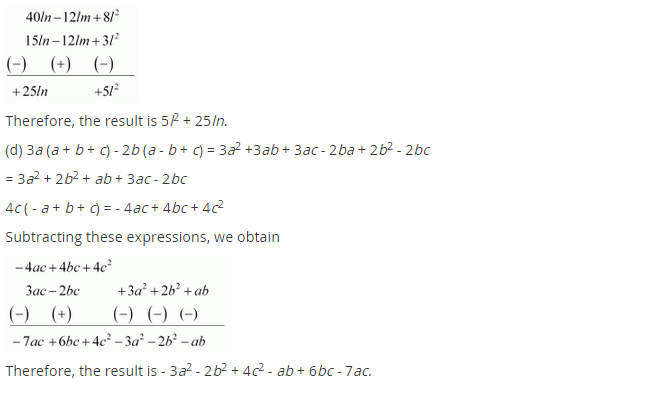
NCERT Solutions for Class 8 Maths Chapter 9 Algebraic Expressions and Identities
Exercise 9.4
Ex 9.4 Class 8 Maths Question 1.
Multiply the binomials:
(i) (2x + 5) and (4x – 3)
(ii) (y – 8) and (3y – 4)
(iii) (2.5l – 0.5m) and (2.5l + 0.5m)
(iv) (a + 3b) and (x + 5)
(v) (2pq + 3q2) and (3pq – 2q2)
(vi) (
Solution:
(i) (2x + 5) × (4x – 3)
= 2x × (4x – 3) + 5 × (4x – 3)
= (2x × 4x) – (3 × 2x) + (5 × 4x) – (5 × 3)
= 8x2 – 6x + 20x – 15
= 8x2 + 14x – 15
(ii) (y – 8) × (3y – 4)
= y × (3y – 4) – 8 × (3y – 4)
= (y × 3y) – (y × 4) – (8 × 3y) + (-8 × -4)
= 3y2 – 4y – 24y + 32
= 3y2 – 28y + 32
(iii) (2.5l – 0.5m) × (2.5l + 0.5m)
= (2.5l × 2.5l) + (2.5l × 0.5m) – (0.5m × 2.5l) – (0.5m × 0.5m)
= 6.25l2 + 1.25ml – 1.25ml – 0.25m2
= 6.25l2 + 0 – 0.25m2
= 6.25l2 – 0.25m2
(iv) (a + 3b) × (x + 5)
= a × (x + 5) + 36 × (x + 5)
= (a × x) + (a × 5) + (36 × x) + (36 × 5)
= ax + 5a + 3bx + 15b
(v) (2pq + 3q2) × (3pq – 2q2)
= 2pq × (3pq – 2q2) + 3q2 (3pq – 2q2)
= (2pq × 3pq) – (2pq × 2q2) + (3q2 × 3pq) – (3q2 × 2q2)
= 6p2q2 – 4pq3 + 9pq3 – 6q4
= 6p2q2 + 5pq3 – 6q4
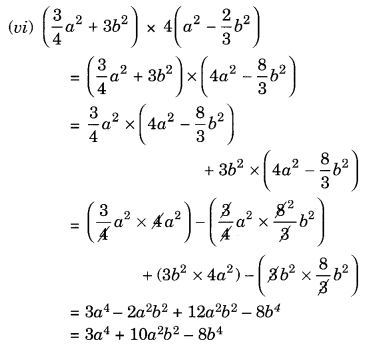
Ex 9.4 Class 8 Maths Question 2.
Find the product:
(i) (5 – 2x) (3 + x)
(ii) (x + 7y) (7x – y)
(iii) (a2 + b) (a + b2)
(iv) (p2 – q2)(2p + q)
Solution:
(i) (5 – 2x) (3 + x)
= 5(3 + x) – 2x(3 + x)
= (5 × 3) + (5 × x) – (2x × 3) – (2x × x)
= 15 + 5x – 6x – 2x2
(ii) (x + 7y) (7x – y)
= x(7x – y) + 7y(7x – y)
= (x × 7x) – (x × y) + (7y × 7x) – (7y × y)
= 7x2 – xy + 49xy – 7y2
= 7x2 + 48xy – 7y2
(iii) (a2 + b) (a + b2)
= a2 (a + b2) + b(a + b2)
= (a2 × a) + (a2 × b2) + (b × a) + (b × b2)
= a3 + a2b2 + ab + b3
(iv) (p2 – q2)(2p + q)
= p2(2p + q) – q2(2p + q)
= (p2 × 2p) + (p2 × q) – (q2 × 2p) – (q2 × q)
= 2p3 + p2q – 2pq2 – q3
Ex 9.4 Class 8 Maths Question 3.
Simplify:
(i) (x2 – 5) (x + 5) + 25
(ii) (a2 + 5)(b3 + 3) + 5
(iii) (t + s2) (t2 – s)
(iv) (a + b) (c – d) + (a – b) (c + d) + 2(ac + bd)
(v) (x + y) (2x + y) + (x + 2y) (x – y)
(vi) (x + y)(x2 – xy + y2)
(vii) (1.5x – 4y)(1.5x + 4y + 3) – 4.5x + 12y
(viii) (a + b + c) (a + b – c)
Solution:
(i) (x2 – 5) (x + 5) + 25
= x2(x + 5) + 5(x + 5) + 25
= x3 + 5x2 – 5x – 25 + 25
= x3 + 5x2 – 5x + 0
= x3 + 5x2 – 5x
(ii) (a2 + 5)(b3 + 3) + 5
= a2(b3 + 3) + 5(b3 + 3) + 5
= a2b3 + 3a2 + 5b3 + 15 + 5
= a2b3 + 3a2 + 5b3 + 20
(iii) (t + s2) (t2 – s)
= t(t2 – s) + s2(t2 – s)
= t3 – st + s2t2 – s3
= t3 + s2t2 – st – s3
(iv) (a + b)(c – d) + (a – b) (c + d) + 2(ac + bd)
= a(c – d) + b(c – d) + a(c + d) – b(c + d) + 2ac + 2bd
= ac – ad + bc – bd + ac + ad – bc – bd + 2ac + 2bd
= ac + ac + 2ac + bc – bc – ad + ad – bd – bd + 2bd
= 4ac + 0 + 0 + 0
= 4ac
(v) (x + y) (2x + y) + (x + 2y) (x – y)
= x(2x + y) + y(2x + y) + x(x – y) + 2y(x – y)
= 2x2 + xy + 2xy + y2 + x2 – xy + 2xy – 2y2
= 2x2 + x2 + xy + 2xy – xy + 2xy + y2 – 2y2
= 3x2 + 4xy – y2
(vi) (x + y)(x2 – xy + y2)
= x(x2 – xy + y2) + y(x2 – xy + y2)
= x3 – x2y + x2y + xy2 – xy2 + y3
= x3 – 0 + 0 + y3
= x3 + y3
(vii) (1.5x – 4y)(1.5x + 4y + 3) – 4.5x.+ 12y
= 1.5x (1.5x + 4y + 3) – 4y(1.5x + 4y + 3) – 4.5x + 12y
= 2.25x2 + 6xy + 4.5x – 6xy – 16y2 – 12y – 4.5x + 12y
= 2.25x2 + 6xy – 6xy + 4.5x – 4.5x + 12y – 12y – 16y2
= 2.25x2 + 0 + 0 + 0 – 16y2
= 2.25x2 – 16y2
(viii) (a + b + c) (a + b – c)
= a(a + b – c) + b(a + b – c) + c(a + b – c)
= a2 + ab – ac + ab + b2 – bc + ac + bc – c2
= a2 + ab + ab – bc + bc – ac + ac + b2 – c2
= a2 + 2ab + b2 – c2 + 0 + 0
= a2 + 2ab + b2 – c2
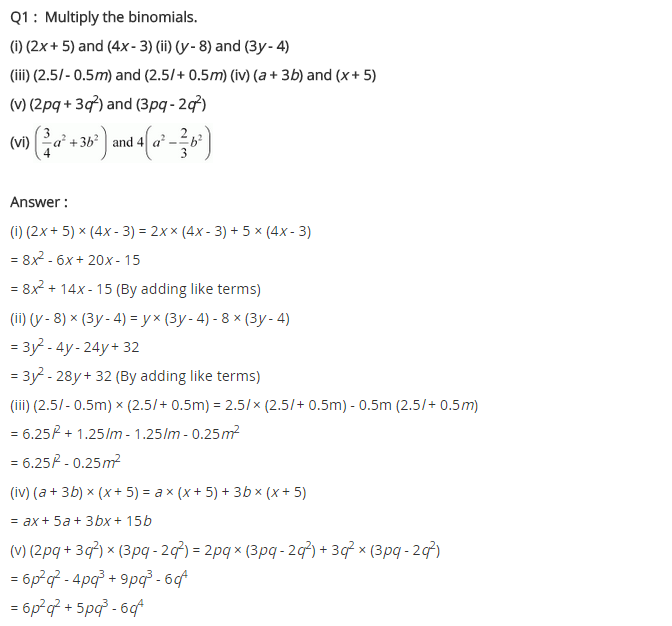

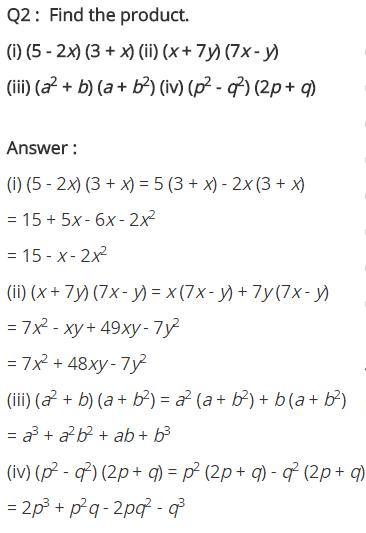
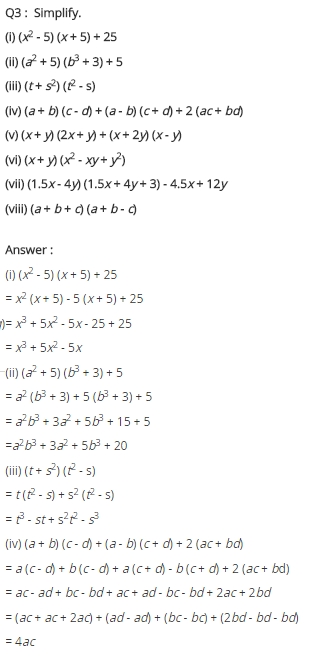
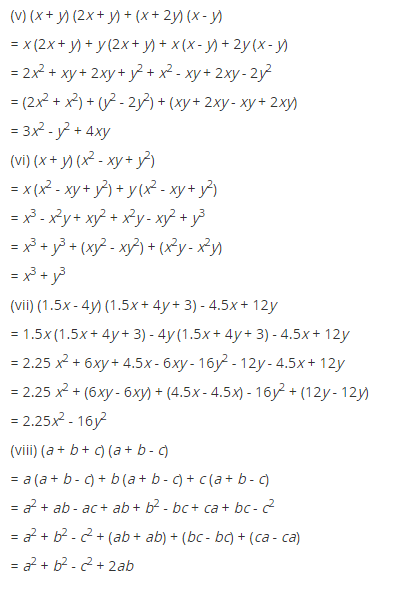
NCERT Solutions for Class 8 Maths Chapter 9 Algebraic Expressions and Identities
Exercise 9.5
Ex 9.5 Class 8 Maths Question 1.
Use a suitable identity to get each of the following products:
(i) (x + 3) (x + 3)
(ii) (2y + 5) (2y + 5)
(iii) (2a – 7) (2a – 7)
(iv) (3a –
(v) (1.1m – 0.4) (1.1m + 0.4)
(vi) (a2 + b2) (-a2 + b2)
(vii) (6x – 7) (6x + 7)
(viii) (-a + c) (-a + c)
(ix) (
(x) (7a – 9b) (7a – 9b)
Solution: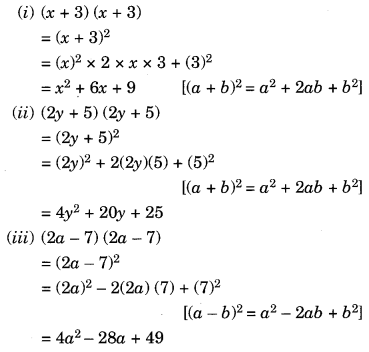
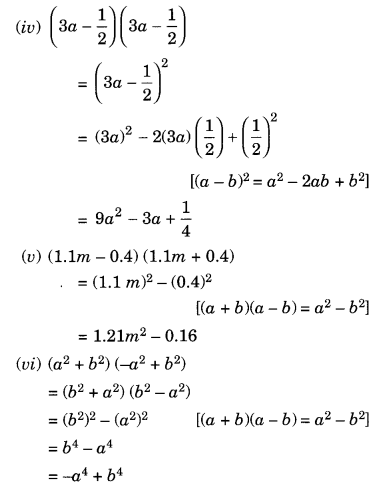
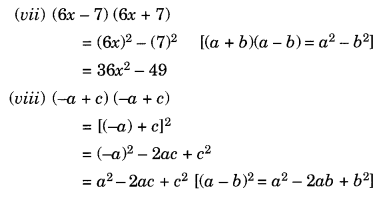
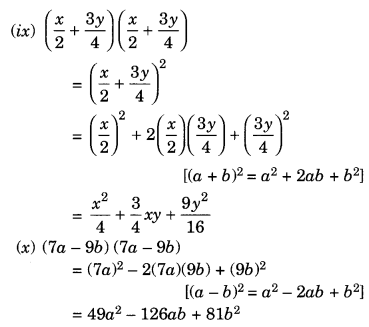
Ex 9.5 Class 8 Maths Question 2.
Use the identity (x + a)(x + b) = x2 + (a + b)x + ab to find the following products.
(i) (x + 3) (x + 7)
(ii) (4x + 5)(4x + 1)
(iii) (4x – 5) (4x – 1)
(iv) (4x + 5) (4x – 1)
(v) (2x + 5y) (2x + 3y)
(vi) (2a2 + 9) (2a2 + 5)
(vii) (xyz – 4) (xyz – 2)
Solution: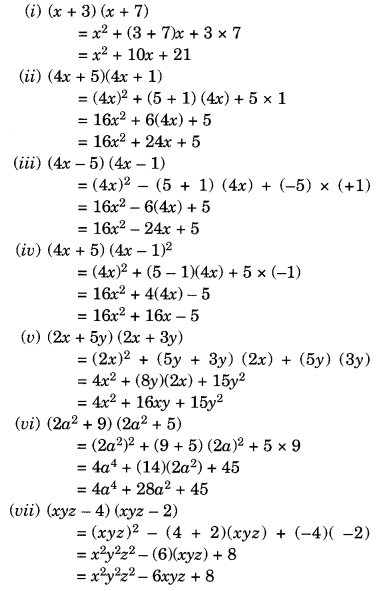
Ex 9.5 Class 8 Maths Question 3.
Find the following squares by using the identities.
(i) (b – 7)2
(ii) (xy + 3z)2
(iii) (6x2 – 5y)2
(iv) (
(v) (0.4p – 0.5q)2
(vi) (2xy + 5y)2
Solution: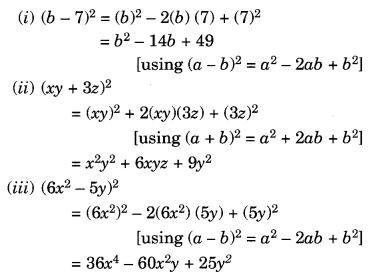
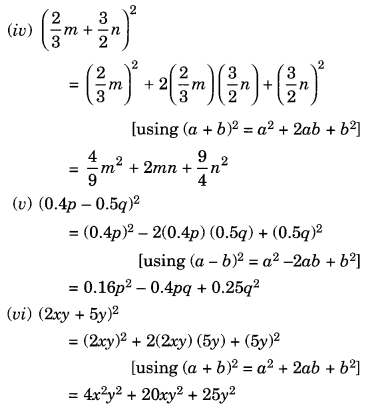
Ex 9.5 Class 8 Maths Question 4.
Simplify:
(i) (a2 – b2)2
(ii) (2x + 5)2 – (2x – 5)2
(iii) (7m – 8n)2 + (7m + 8n)2
(iv) (4m + 5n)2 + (5m + 4n)2
(v) (2.5p – 1.5q)2 – (1.5p – 2.5q)2
(vi) (ab + bc)2 – 2ab2c
(vii) (m2 – n2m)2 + 2m3n2
Solution:
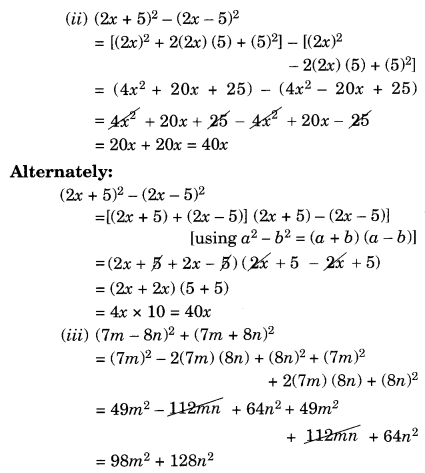
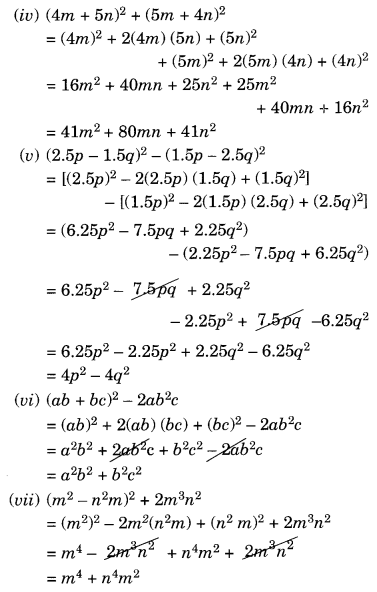
Ex 9.5 Class 8 Maths Question 5.
Show that:
(i) (3x + 7)2 – 84x = (3x – 7)2
(ii) (9p – 5q)2 + 180pq = (9p + 5q)2
(iii) (
(iv) (4pq + 3q)2 – (4pq – 3q)2 = 48pq2
(v) (a – b)(a + b) + (b – c) (b + c) + (c – a) (c + a) = 0
Solution: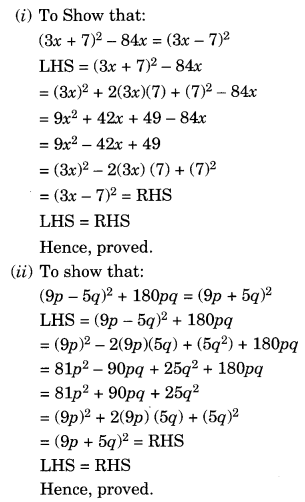
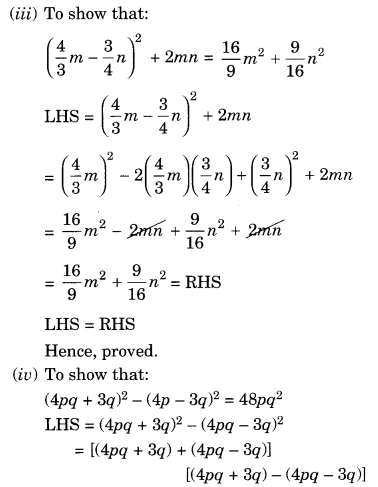
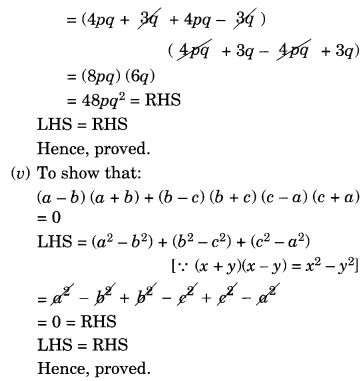
Ex 9.5 Class 8 Maths Question 6.
Using identities, evaluate:
(i) 712
(ii) 992
(iii) 1022
(iv) 9982
(v) 5.22
(vi) 297 × 303
(vii) 78 × 82
(viii) 8.92
(ix) 1.05 × 9.5
Solution: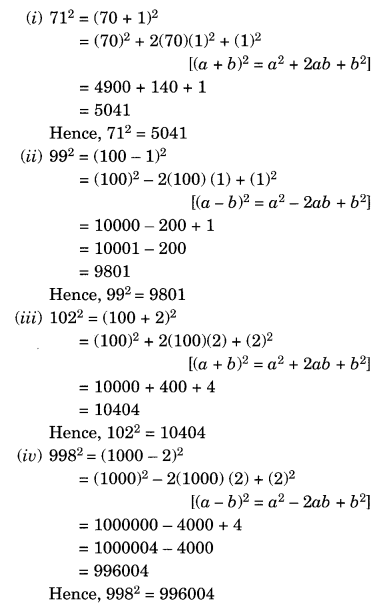
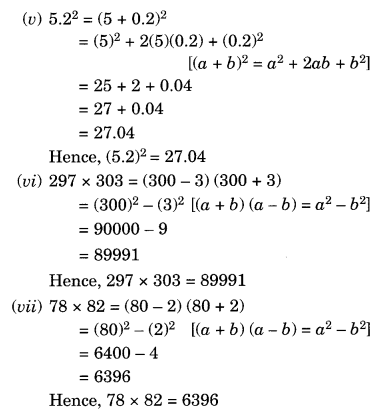
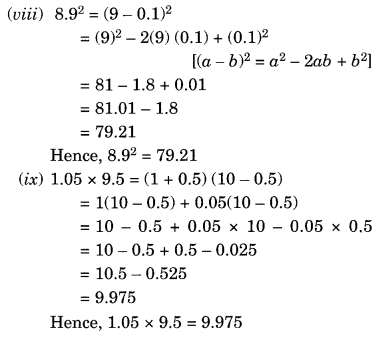
Ex 9.5 Class 8 Maths Question 7.
Using a2 – b2 = (a + b) (a – b), find
(i) 512 – 492
(ii) (1.02)2 – (0.98)2
(iii) 1532 – 1472
(iv) 12.12 – 7.92
Solution:
(i) 512 – 492 = (51 + 49) (51 – 49) = 100 × 2 = 200
(ii) (1.02)2 – (0.98)2 = (1.02 + 0.98) (1.02 – 0.98) = 2.00 × 0.04 = 0.08
(iii) 1532 – 1472 = (153 + 147) (153 – 147) = 300 × 6 = 1800
(iv) 12.12 – 7.92 = (12.1 + 7.9) (12.1 – 7.9) = 20.0 × 4.2 = 84
Ex 9.5 Class 8 Maths Question 8.
Using (x + a) (x + b) = x2 + (a + b)x + ab, find
(i) 103 × 104
(ii) 5.1 × 5.2
(iii) 103 × 98
(iv) 9.7 × 9.8
Solution:
(i) 103 × 104 = (100 + 3)(100 + 4) = (100)2 + (3 + 4) (100) + 3 × 4 = 10000 + 700 + 12 = 10712
(ii) 5.1 × 5.2 = (5 + 0.1) (5 + 0.2) = (5)2 + (0.1 + 0.2) (5) + 0.1 × 0.2 = 25 + 1.5 + 0.02 = 26.5 + 0.02 = 26.52
(iii) 103 × 98 = (100 + 3) (100 – 2) = (100)2 + (3 – 2) (100) + 3 × (-2) = 10000 + 100 – 6 = 10100 – 6 = 10094
(iv) 9.7 × 9.8 = (10 – 0.3) (10 – 0.2) = (10)2 – (0.3 + 0.2) (10) + (-0.3) (-0.2) = 100 – 5 + 0.06 = 95 + 0.06 = 95.06
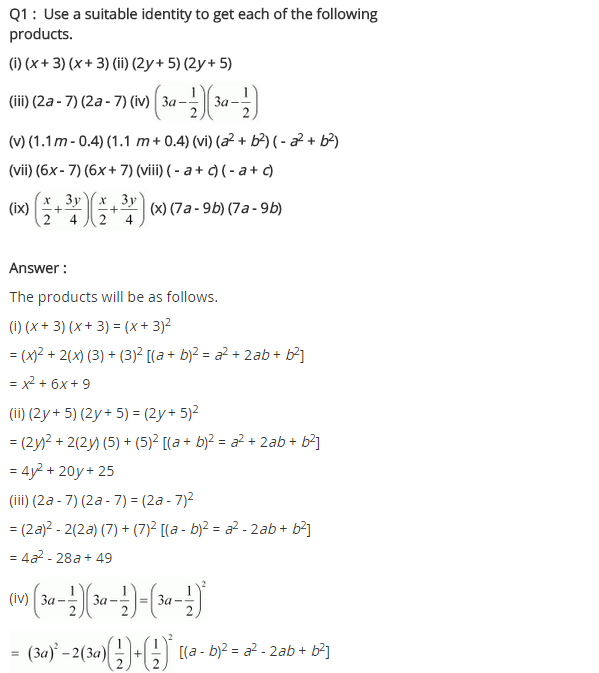
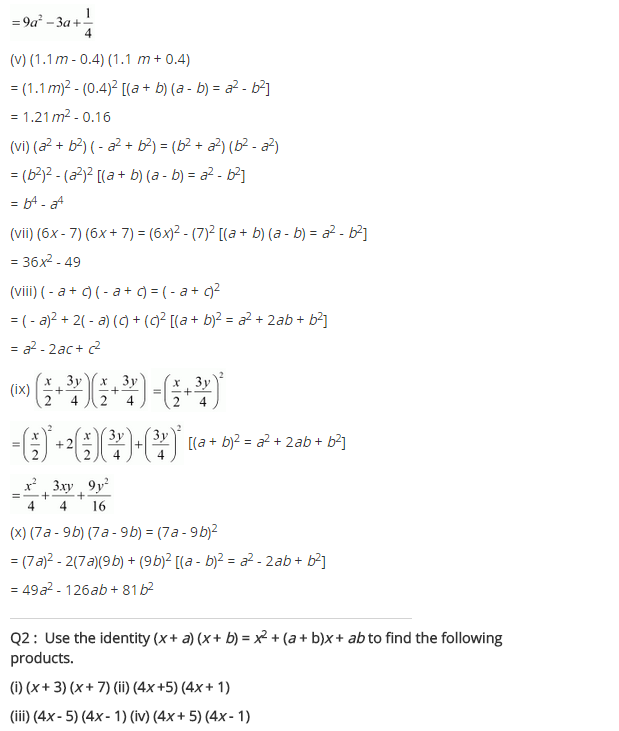
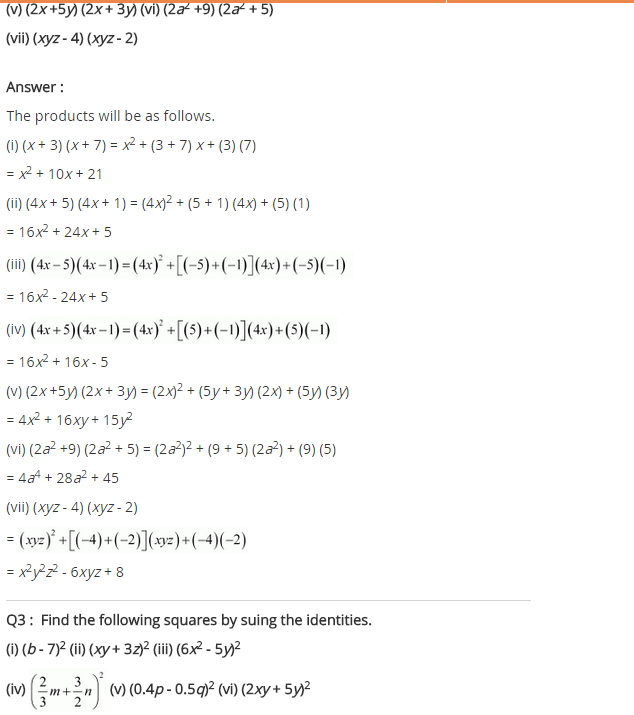
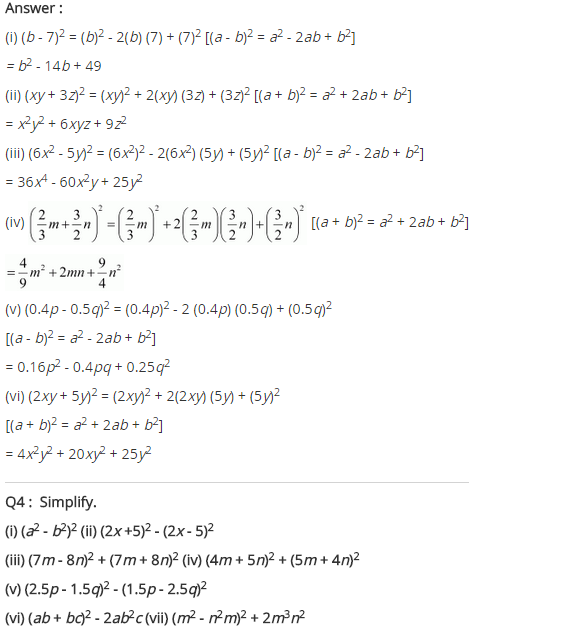
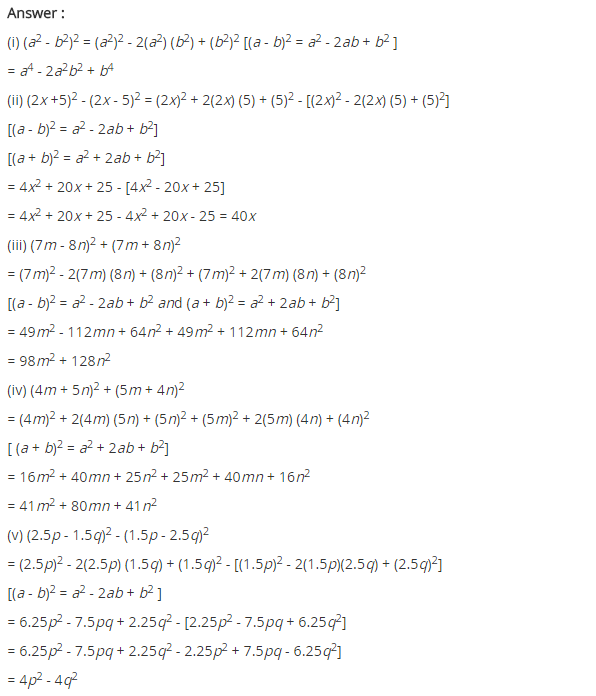
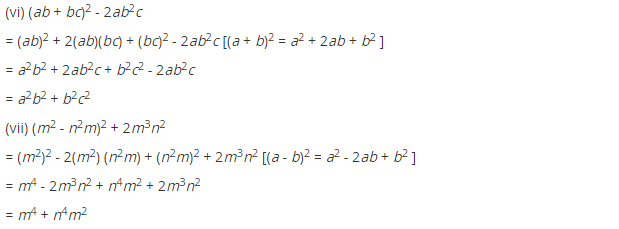
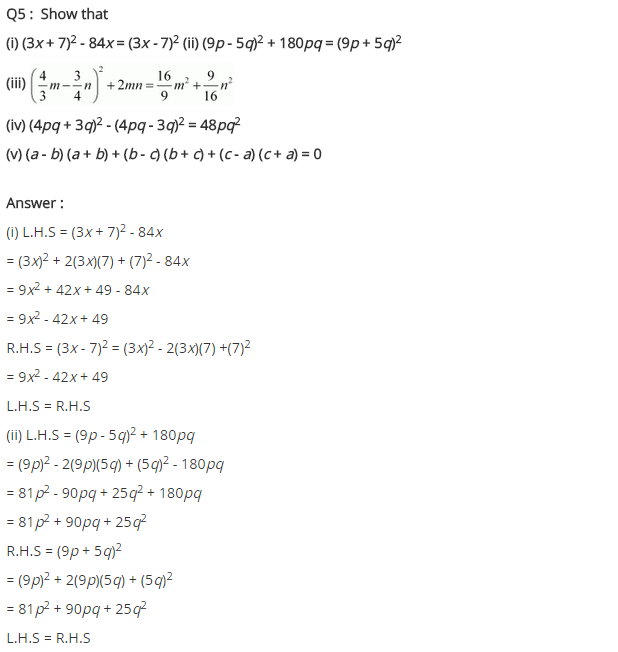
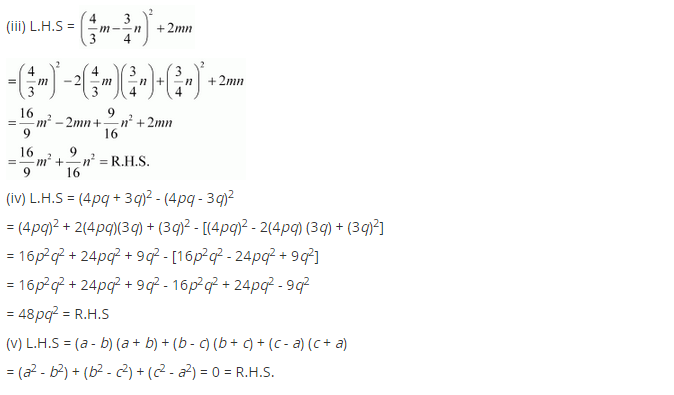
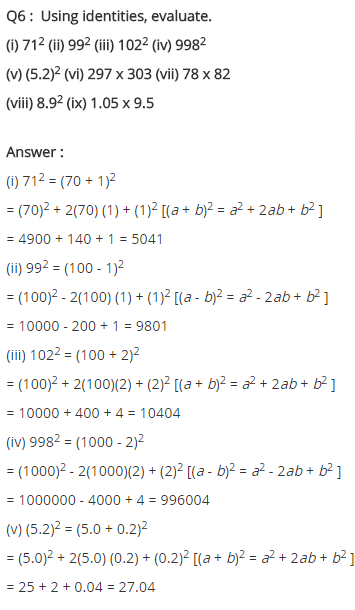
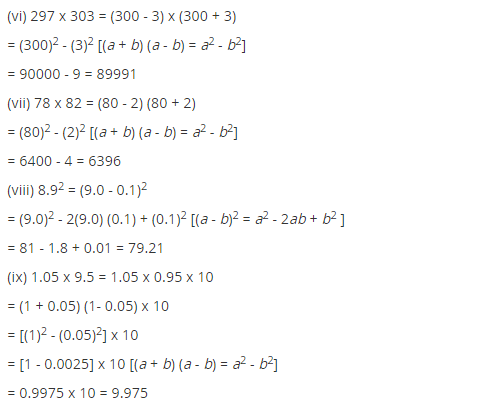
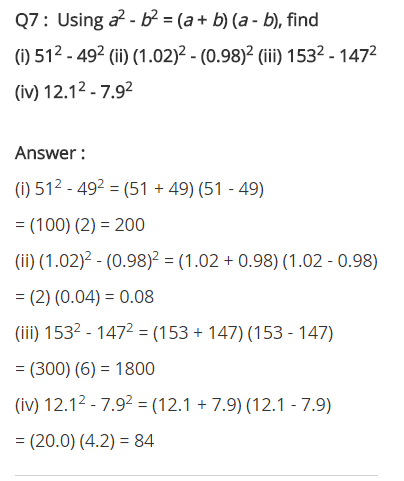
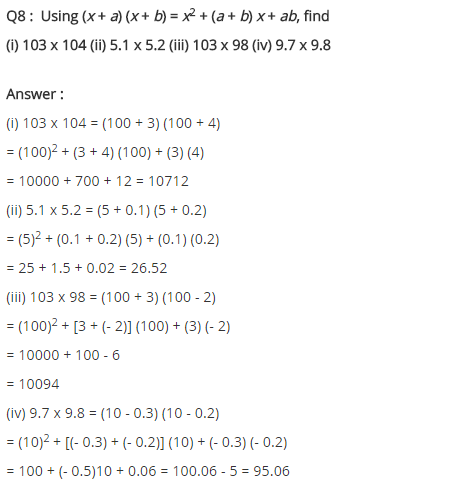
- Chapter 1 Rational Numbers
- Chapter 2 Linear Equations in One Variable
- Chapter 3 Understanding Quadrilaterals
- Chapter 4 Practical Geometry
- Chapter 5 Data Handling
- Chapter 6 Squares and Square Roots
- Chapter 7 Cubes and Cube Roots
- Chapter 8 Comparing Quantities
- Chapter 9 Algebraic Expressions and Identities
- Chapter 10 Visualising Solid Shapes
- Chapter 11 Mensuration
- Chapter 12 Exponents and Powers
- Chapter 13 Direct and Indirect proportions
- Chapter 14 Factorisation
- Chapter 15 Introduction to Graphs
- Chapter 16 Playing with Numbers
.png)
.png)